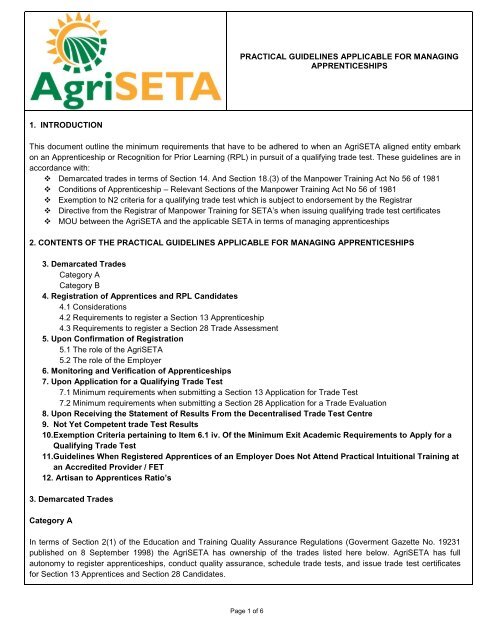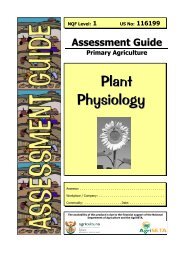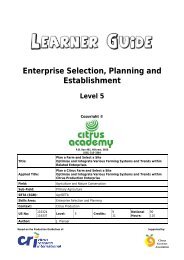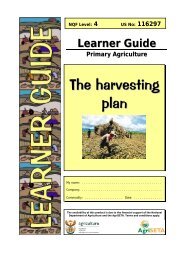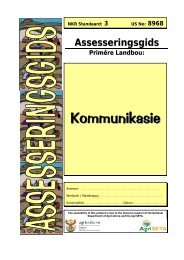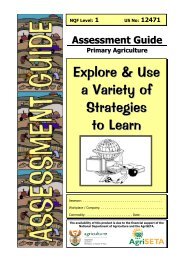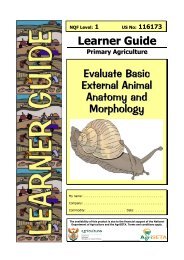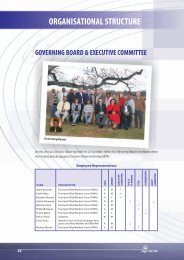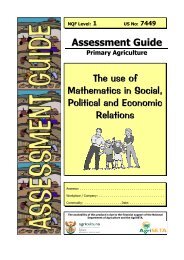Matters arising from the FoodBev Apprenticeships - AgriSETA
Matters arising from the FoodBev Apprenticeships - AgriSETA
Matters arising from the FoodBev Apprenticeships - AgriSETA
You also want an ePaper? Increase the reach of your titles
YUMPU automatically turns print PDFs into web optimized ePapers that Google loves.
PRACTICAL GUIDELINES APPLICABLE FOR MANAGINGAPPRENTICESHIPS1. INTRODUCTIONThis document outline <strong>the</strong> minimum requirements that have to be adhered to when an <strong>AgriSETA</strong> aligned entity embarkon an Apprenticeship or Recognition for Prior Learning (RPL) in pursuit of a qualifying trade test. These guidelines are inaccordance with: Demarcated trades in terms of Section 14. And Section 18.(3) of <strong>the</strong> Manpower Training Act No 56 of 1981 Conditions of Apprenticeship – Relevant Sections of <strong>the</strong> Manpower Training Act No 56 of 1981 Exemption to N2 criteria for a qualifying trade test which is subject to endorsement by <strong>the</strong> Registrar Directive <strong>from</strong> <strong>the</strong> Registrar of Manpower Training for SETA’s when issuing qualifying trade test certificates MOU between <strong>the</strong> <strong>AgriSETA</strong> and <strong>the</strong> applicable SETA in terms of managing apprenticeships2. CONTENTS OF THE PRACTICAL GUIDELINES APPLICABLE FOR MANAGING APPRENTICESHIPS3. Demarcated TradesCategory ACategory B4. Registration of Apprentices and RPL Candidates4.1 Considerations4.2 Requirements to register a Section 13 Apprenticeship4.3 Requirements to register a Section 28 Trade Assessment5. Upon Confirmation of Registration5.1 The role of <strong>the</strong> <strong>AgriSETA</strong>5.2 The role of <strong>the</strong> Employer6. Monitoring and Verification of <strong>Apprenticeships</strong>7. Upon Application for a Qualifying Trade Test7.1 Minimum requirements when submitting a Section 13 Application for Trade Test7.2 Minimum requirements when submitting a Section 28 Application for a Trade Evaluation8. Upon Receiving <strong>the</strong> Statement of Results From <strong>the</strong> Decentralised Trade Test Centre9. Not Yet Competent trade Test Results10.Exemption Criteria pertaining to Item 6.1 iv. Of <strong>the</strong> Minimum Exit Academic Requirements to Apply for aQualifying Trade Test11.Guidelines When Registered Apprentices of an Employer Does Not Attend Practical Intuitional Training atan Accredited Provider / FET12. Artisan to Apprentices Ratio’s3. Demarcated TradesCategory AIn terms of Section 2(1) of <strong>the</strong> Education and Training Quality Assurance Regulations (Goverment Gazette No. 19231published on 8 September 1998) <strong>the</strong> <strong>AgriSETA</strong> has ownership of <strong>the</strong> trades listed here below. <strong>AgriSETA</strong> has fullautonomy to register apprenticeships, conduct quality assurance, schedule trade tests, and issue trade test certificatesfor Section 13 Apprentices and Section 28 Candidates.Page 1 of 6
Designated Trade Section 13 Section 28Automotive Mechanic Full Autonomy by <strong>AgriSETA</strong> Full Autonomy by <strong>AgriSETA</strong>Electrician Full Autonomy by <strong>AgriSETA</strong> Full Autonomy by <strong>AgriSETA</strong>Instrument Mechanician Full Autonomy by <strong>AgriSETA</strong> Full Autonomy by <strong>AgriSETA</strong>Fitter Full Autonomy by <strong>AgriSETA</strong> Full Autonomy by <strong>AgriSETA</strong>Fitter and Turner Full Autonomy by <strong>AgriSETA</strong> Full Autonomy by <strong>AgriSETA</strong>Turner Full Autonomy by <strong>AgriSETA</strong> Full Autonomy by <strong>AgriSETA</strong>Plater / Welder Full Autonomy by <strong>AgriSETA</strong> Full Autonomy by <strong>AgriSETA</strong>Mill Wright (Electromechanician) Full Autonomy by <strong>AgriSETA</strong> Full Autonomy by <strong>AgriSETA</strong>Category BAgrISETA entered into a Memorandum of Understanding (MOU) with <strong>the</strong> MerSETA to extend its scope of trades. The<strong>AgriSETA</strong> as a result have full autonomy to register apprenticeships, conduct quality assurance, schedule Trade Tests,and issue Trade Test certificates for Section 13 Apprentices for non-designated trades tabled here below. The <strong>AgriSETA</strong>manages Application for Trade Tests and schedule Trade Test dates for Section 28 Candidates via <strong>the</strong> MerSETA.MerSETA is responsible for issuing Section 28 Trade Test certificates for Category B trades.Designated Trade Section 13 Section 28Diesel Mechanic Full Autonomy by <strong>AgriSETA</strong> MerSETA DirectedDiesel Fitter Full Autonomy by <strong>AgriSETA</strong> MerSETA DirectedTractor Mechanic Full Autonomy by <strong>AgriSETA</strong> MerSETA DirectedBoilermaker Full Autonomy by <strong>AgriSETA</strong> MerSETA DirectedRefrigeration Mechanic (Com. & Ind.) Full Autonomy by <strong>AgriSETA</strong> MerSETA DirectedRigger Full Autonomy by <strong>AgriSETA</strong> MerSETA DirectedThere is absolutely no difference between <strong>the</strong> Section 13 and Section 28 Trade Tests. It is a condition of <strong>the</strong> MoUbetween <strong>the</strong> <strong>AgriSETA</strong> and MerSETA that Trade Test components, time allocated for Trade Tests and QualityStandards (mark sheets) are exactly <strong>the</strong> same. Trade Tests Certificates displaying <strong>the</strong> <strong>AgriSETA</strong> Logo have <strong>the</strong> samevalidity and <strong>the</strong> bearer of such certificate will get <strong>the</strong> same national recognition.4. Registration of Apprentices and RPL Candidates4.1 ConsiderationsSETA’s have an obligation to report to <strong>the</strong> Department of Higher Education (DHET) on <strong>the</strong> subject of Apprenticeshiptraining and <strong>the</strong> number of persons qualifying as Artisans in its particular sector. This emphasises <strong>the</strong> importance toregister Apprentices with <strong>the</strong> <strong>AgriSETA</strong> whe<strong>the</strong>r funded or not.Application to fund apprenticeships is optional. Employers may apply for funding <strong>from</strong> <strong>the</strong> <strong>AgriSETA</strong> by means of <strong>the</strong>2 Discretionary Grant Application for Bursaries, Internships, Workplace Experience, and <strong>Apprenticeships</strong> Application(BIWA) Form. Complete Sections A., B.2 and C. of <strong>the</strong> BIWA document and return to; The Manager: <strong>Apprenticeships</strong>,<strong>AgriSETA</strong> House, 529 Belvedere Street, Arcadia, 0083 or P O Box 26024, Arcadia, 0007, RSA. The process for funding<strong>from</strong> this point onwards is outlined in <strong>the</strong> 3 Discretionary Grant Notification For <strong>Apprenticeships</strong>.4.2 Requirements to register a Section 13 Apprenticeshipi. The employer conduct a self evaluation against; 8 Workplace Provider Criteria, 9 Workplace Readiness, and uponcompliance complete and prepare a 9 Workplace Readiness Report for submission to <strong>the</strong> <strong>AgriSETA</strong>;ii. The candidate must be at least 16 years of age, all trades; Minimum of Standard 8 or Grade 10 withma<strong>the</strong>matics and science or a full N1;iii. Candidates must be declared 10 Medically Fit before engaging into a Apprenticeship Contract;iv. The candidate must be a South African Citizen and in possession of a valid National Identity Document (ID);v. Complete and adhere to Part A., B., C. (if applicable) and D. of <strong>the</strong> 4 Contract of Apprenticeship.Take cognizance that an Apprenticeship Contract must be registered with <strong>the</strong> <strong>AgriSETA</strong> within 30 days upon signing by<strong>the</strong> respective parties.Page 2 of 6
4.3 Requirements to register a Section 28 Trade Evaluation (Registration is only compulsory when funded by <strong>the</strong><strong>AgriSETA</strong>)i. The candidate has to comply with one of <strong>the</strong> following entry requirements:-A. A minimum of 6 (six) years relevant on <strong>the</strong> job practical experience should <strong>the</strong> candidate hold aqualification o<strong>the</strong>r than N2 trade <strong>the</strong>ory;B. A minimum of 5(five) years relevant on <strong>the</strong> job practical experience and relevant N2 <strong>the</strong>ory;C. A minimum of 4(four) years relevant on <strong>the</strong> job practical experience and N2 with a four subjectscertificate (with relevant trade <strong>the</strong>ory);ii. Confirmation <strong>from</strong> a MerSETA accredited Training Provider / FET that <strong>the</strong> candidate had been subjected to apractical skills level evaluation to identify current skills level and recommendation for fur<strong>the</strong>r training interventionsin pursuit of a 6 Qualifying Trade Assessment against <strong>the</strong> designated trade;iii. Proof of highest qualification or Letter of Oath of highest qualification inclusive of a list of subjectsiv. A detailed breakdown reporting on previous and current practical experience aligned with <strong>the</strong> designatedtraining schedule on company letterhead (Separate letters <strong>from</strong> each previous and current employer in terms ofitem 4.3 i. are required). 7 Samples Letters reporting on detailed breakdown include:-7a Automotive Mechanic7b Electrician7c Instrument Mechanician7d Fitter7e Fitter and Turner7f Turner7g Plater / Welder7h Mill Wright (Electromechanician)7i Diesel Mechanic7j Diesel Fitter7k Tractor Mechanic7l Boilermaker7m Refrigeration Mechanic (Com. & Ind.)7n Riggerv. Complete and adhere to Part A., B. and C. of <strong>the</strong> 5 RPL Agreement For Section 28 Evaluation.5. Upon Confirmation Of Registration:5.1 The role of <strong>the</strong> <strong>AgriSETA</strong>i. Submit <strong>the</strong> 4 Contract of Apprenticeship / 5 RPL Agreement For Section 28 Evaluation for approval by <strong>the</strong> dulyauthorised of <strong>the</strong> <strong>AgriSETA</strong>;ii. The employer is informed about non-conformances if applicable and allow reasonable time for corrections;iii. The BIWA Administrator issues a unique <strong>AgriSETA</strong> Apprenticeship Contract number;iv. Notify <strong>the</strong> employer that <strong>the</strong> Apprenticeship had been approved and issue all relevant guidelines / supportingdocuments:- Signed copy of <strong>the</strong> 4 Contract of Apprenticeship or if applicable 5 RPL Agreement For Section 28Evaluation11 Workplace Logbooks‣11a Automotive Mechanic‣11b Electrician‣11c Instrument Mechanician‣11d Fitter‣11e Fitter and Turner‣11f Turner‣11g Plater / Welder‣11h Mill Wright (Electromechanician)‣11i Diesel Mechanic‣11j Diesel Fitter‣11k Tractor Mechanic‣11l Boilermaker‣11m Refrigeration Mechanic (Com. & Ind.)‣11n RiggerPage 3 of 6
12 Apprentice Development Plan13 Guidelines Applicable To Record Keepingv. A duly authorised representative of <strong>AgriSETA</strong> schedule a physical site visit to verify Workplace Providercompliance;5.2 The role of <strong>the</strong> EmployerDeploy <strong>the</strong> candidate in <strong>the</strong> workplacei. Institute 9 support systems in <strong>the</strong> workplace;ii. Orientate designated Training Coordinator, Mentor, Workplace Coach and Apprentice(s) about 9 roles andresponsibilities;iii. Guide apprentices and workplace coach to 14 maintain logbook and supplementary notes;iv. Maintain a safe work environment in accordance with Health and Safety practices;v. Conform to 8 Workplace Provider Criteria guidelines as workplace provider;vi. Proof of sufficient and appropriately qualified persons that may serve as workplace coach / mentor for <strong>the</strong>apprentice;vii. Submit a signed 12 Apprentice Development Plan for each apprentice;vi. Submit proof of a signed Fixed Term Conditions of Employment for each Apprentice or RPL Candidate ifunemployed of Contract of Employment if employed.6. Monitoring and Verification of <strong>Apprenticeships</strong>The <strong>AgriSETA</strong> in terms of good governance of <strong>Apprenticeships</strong> require written progress reports at intervals of six months.The 15 Monitoring and Verification Report (MVR) may serve as reporting instrument and has to be completed by <strong>the</strong> ei<strong>the</strong>r<strong>the</strong> employer or a duly authorised <strong>AgriSETA</strong> representative. The duly authorised <strong>from</strong> <strong>AgriSETA</strong> conduct a physicalmonitoring and verification site visit (at least) once in a period of 12 months for <strong>the</strong> duration of <strong>the</strong> Apprenticeship. The15 Monitoring and Verification Report (MVR) may be completed by a duly authorised <strong>AgriSETA</strong> representative or <strong>the</strong>employer. The 9 Workplace Readiness Report serves as first report. The <strong>AgriSETA</strong> designed 15 Monitoring and VerificationReport (MVR) template may be used by <strong>the</strong> employer when having to report on <strong>the</strong> learning progress. Alternatively <strong>the</strong>employer may use its own progress report provided that it covers <strong>the</strong> minimum information as required for example:i. Location of <strong>the</strong> apprentice(s);ii. Names of <strong>the</strong> apprentices and indication of progress against <strong>the</strong> designated training schedule;iii. Company representative details and name of designated workplace coach (journeyman);iv. Verification of Logbooks and supplementary notes;v. Verification of attendance records, leave records, accidents and incidents recorded, disciplinary matters, staffwelfare, transgressions, recommendation, progress against plan, scheduling of fur<strong>the</strong>r training interventions;vi. Access to tools and equipment;vii. Feedback <strong>from</strong> <strong>the</strong> journeyman;viii. Feedback <strong>from</strong> <strong>the</strong> apprentice.7. Upon Application for a Qualifying Trade Test:The employer prepares <strong>the</strong> Application for Trade Test and conduct a 16 Application for Trade Test Self Check for eachapplication. Original hard copies of <strong>the</strong> application may upon compliance against <strong>the</strong> qualifying criteria be submitted to<strong>the</strong> <strong>AgriSETA</strong>. The <strong>AgriSETA</strong> acknowledges receipt of <strong>the</strong> application and screen <strong>the</strong> contents and attachments forcompliance. The <strong>AgriSETA</strong> BIWA Administrator processes <strong>the</strong> application upon approval and issue a unique systemsgenerated serial number for each application. The <strong>AgriSETA</strong> notify <strong>the</strong> designated Decentralised Trade Test Centre toissue Trade Test dates. The Decentralised Trade Test Centre issues a trade test date and notify <strong>the</strong> employer and <strong>the</strong><strong>AgriSETA</strong> accordingly.7.1 Minimum requirements when submitting a 17 Section 13 Application for Trade Testi. Complete 2 x original signed copies of this application form;ii. Attach 2 x original certified copies of <strong>the</strong> 11 Workplace Logbooks (apprentice ensure that 100% are signed);iii. Attach 2 x original certified copies of <strong>the</strong> national ID;iv. Attach 2 x original certified copies of a valid N2 certificate with Ma<strong>the</strong>matics, Relevant Trade Theory, plus twoPage 4 of 6
elevant subjects as prescribed by <strong>the</strong> designated training schedule or 19 Exemption Letter for N2 <strong>from</strong> anaccredited training provider as stated in Item 9. of this document;v. Attach 2 x original 18 Signed Letters on Company Letterhead declaring that <strong>the</strong> Apprentice:-A. Had been/are employed and received workplace exposure at <strong>the</strong> company under mentorship of a qualifiedartisan for <strong>the</strong> designated tradeB. Completed all <strong>the</strong> practical and <strong>the</strong>oretical training in accordance with <strong>the</strong> MERSETA training schedule for<strong>the</strong> designated tradeC. Is trade test ready ei<strong>the</strong>r <strong>from</strong> <strong>the</strong> employer or <strong>from</strong> an accredited training provider if <strong>the</strong> apprentice attendedpractical institutional training.D. Completed <strong>the</strong> minimum period 85 weeks practical workplace exposurevi. Enclose a copy of previous Trade Test Statement of Results (NYC declaration);vii. Attach proof of payment of Trade Test fee at <strong>the</strong> designated Trade Test Centre.7.2 Minimum requirements when submitting a 20 Section 28 Application for Trade Evaluationi. Complete 2 x original signed copies of this application form;ii. Attach 2 x certified copies of <strong>the</strong> national ID;iii. Attach 2 x certified copies of highest qualification or affidavit of highest qualification including a list of subjects;iv. Attach 2 x originally 21 Signed Letters on Company Letterhead:-A. Declaring that <strong>the</strong> Candidate is employed / unemployedB. Giving a detailed a breakdown of practical workplace experience (previous and current employer onseparate letterheads) against <strong>the</strong> designated training scheduleC. Recommendation that <strong>the</strong> apprentice is Trade Test Ready; also attach a Trade Test Readiness declaration<strong>from</strong> an accredited Training Provider / FETD. Declaring that <strong>the</strong> apprentice acquired practical experience in <strong>the</strong> designated tradev. Attach 2 x certified copies of previous trade test results (NYC declaration) if applicable;vi. Attach proof of payment of trade test fee at <strong>the</strong> designated Trade Test Centre.8. Upon Receiving <strong>the</strong> Statement of Results From The Decentralised Trade Test CentreThe Decentralised Trade Test Centre notifies <strong>the</strong> employer and <strong>AgriSETA</strong> about <strong>the</strong> outcome of <strong>the</strong> Trade Test; issue acopy of <strong>the</strong> Trade Test Statement of Results to <strong>the</strong> Employer and <strong>the</strong> original signed document to <strong>the</strong> <strong>AgriSETA</strong>.<strong>AgriSETA</strong> print a Trade Test Certificate and prepare supporting evidence for endorsement by <strong>the</strong> duly authorised<strong>AgriSETA</strong> designate and <strong>the</strong> Registrar of Manpower Training. The following evidence is attached for perusal by <strong>the</strong>Registrar of Manpower Training:i. Original Trade Test Certificate signed by <strong>the</strong> duly authorised <strong>AgriSETA</strong> designate;ii. Original application for a qualifying trade testiii. Original registered contract of apprenticeship (only section 13 Apprentices) for <strong>the</strong> designated trade signed byall stakeholdersiv. Original signed Medical Examination of <strong>the</strong> candidatev. Original certified copy of <strong>the</strong> logbook / modules (only section 13 Apprentices)vi. Original certified copy of <strong>the</strong> national IDvii. Original signed declaration of employer on company letterheadviii. Original Competency Declaration (Statement of Results) signed by <strong>the</strong> Accredited Trade Test Centre and <strong>the</strong>candidateix. Previous Trade Test Results should it be <strong>the</strong> 2 nd or 3 rd attempt to pass <strong>the</strong> qualifying trade testx. Proof of accreditation of <strong>the</strong> decentralised trade test centreThe <strong>AgriSETA</strong> hand <strong>the</strong> original signed Trade Test Certificate to <strong>the</strong> employer.9. Not Yet Competent trade Test ResultsA candidate will be allowed three Trade Test attempts. The following conditions and time line applies between <strong>the</strong> firstunsuccessful Trade Test attempt and <strong>the</strong> second (or subsequent) attempt.Page 5 of 6
i. The employer submit evidence that remedial training took place;ii. The employer submit evidence that <strong>the</strong> apprentices received supplementary workplace experience to redress<strong>the</strong> skills gap;iii. An Application for trade test may not be furnished within 3 months <strong>from</strong> date of issuing <strong>the</strong> last Trade TestResults;iv. That <strong>the</strong> employer submits a full Application for a Qualifying Trade Test which conforms to all <strong>the</strong> requirementsof such an application.10. Exemption Criteria Pertaining To Item 6.1. Iv. Of The Minimum Exit Academic Requirements To Apply For AQualifying Trade TestThe entry academic requirement to register as Section 13 Apprentice is Standard 8 or Grade 10 with ma<strong>the</strong>matics andscience or a full N1. The candidate may be exempted <strong>from</strong> holding a full N2 academic qualification at exit level uponsuccessful completion of Competency Based Modular Training (CBMT) demonstrating that <strong>the</strong> Ma<strong>the</strong>matical-,Engineering Science-, Technology-, and Trade Theory components had been sufficiently covered during <strong>the</strong> practicalinstitutional phase.a) A candidate that is holding a qualification higher than N2 but without N2 trade <strong>the</strong>ory must have a full technicalqualification (N3 or better) including ma<strong>the</strong>matics and relevant subjects.b) A candidate with minimum N2 without relevant trade <strong>the</strong>ory must obtain an exemption letter issued by an accreditedinstitution.c) A candidate with one N2 subject which is not a relevant trade <strong>the</strong>ory must obtain an exemption letter certificate issuedby an accredited institution.A candidate may however qualify for exemption <strong>from</strong> a full N2 qualification when holding a relevant Learnership at NQFLevel 2 for <strong>the</strong> designated trade.11. Guidelines When Registered Apprentices Of An Employer Does Not Attend Practical Intuitional Training AtAn Accredited Provider / FETRead in conjunction with Item 10. an Exemption Letter does not replace a N2 qualification.Deciding against practical institutional training at an FET / Accredited Provider o<strong>the</strong>r than trade test preparation when acandidate complies to <strong>the</strong> exit academic qualification place an enormous responsibility on <strong>the</strong> employer to support <strong>the</strong>apprentice in preparing for a qualifying trade test. This approach does not allow any room for error against <strong>the</strong>designated training schedule, Item 7.1v.C. and 7.2v.C. applies.12. Artisan to Apprentices Ratio’sThe physical environment of some workplaces has an appetite for risk aggravating <strong>the</strong> Artisan to Apprentices ratio. Thefollowing guidelines may be considered subject to a physical workplace compliance site inspection.A ratio of 1:2 qualified Artisan to Apprentices for <strong>the</strong> same designated trade is manageable. The Artisan to Apprenticeratio may increase to 1:4 when each Apprentice is assigned to a competent Semi-skilled person with 5 yearsexperience for <strong>the</strong> same designated trade.For Electricians and Mill Wrights a ratio of 1:1 in <strong>the</strong> first year applies which may expand to 1:2 in <strong>the</strong> second yearprovided that <strong>the</strong> apprentices completed 50% of <strong>the</strong> modular training against <strong>the</strong> designated training schedule at anaccredited training provider.Page 6 of 6


